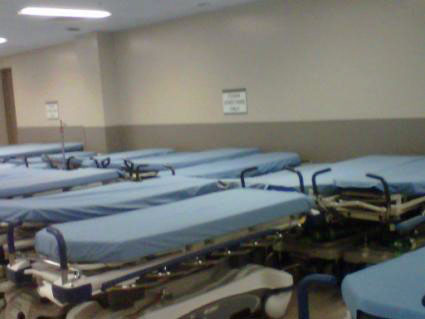Clean transport no longer a stretch
Imagine walking the equivalent of the Vancouver Sun Run – and a good deal more – every day on the job. Now, imagine walking that same distance while transporting patients or items. At VGH, our porters do just that. It’s hard work and it shouldn’t put the health of patients, porters — or anyone else in the vicinity of a stretcher — at risk. Thanks to new cleaning procedures, it won’t.
“Ensuring a safe journey for patients and porters is our priority,” says Mary Heim, supervisor, patient transport. “Cleaned stretchers are essential for safe transport, but with so much demand for stretchers, maintaining a clean fleet hasn’t always been easy.”
The challenge, says Mary, is two-fold: ensuring stretchers are cleaned after every use and knowing which ones are clean or dirty. Our new standard operating procedures for cleaning stretchers address both issues.
Reducing risk of infection
While porters have always cleaned stretchers between patients, other departments also use stretchers regularly. Multiple users can lead to confusion and so our new procedures require all hospital staff, including our colleagues in diagnostic imaging, to:
- remove linen directly after use and wipe down the high-touch points – mattress, handrails and push handles – with Cavi or Oxivir wipes
- make up the stretcher with fresh blue sheets
- deposit the clean stretcher in a designated storage location

Cleaned and ready to roll: At the VGH stretcher “parking lot” in Jim Pattison Pavilion, stretchers are made up with the telltale blue sheets indicating they’re clean.
“Used stretchers left uncleaned in hallways and corridors put everyone at risk,” says Sydney Scharf, infection control practitioner. “When we all do our part to clean and store stretchers in designated areas, we reduce the risk of infection for patients, porters and everyone else on campus.”
To supplement cleanings between patients, Aramark housekeepers are thoroughly cleaning all stretchers placed in the VGH stretcher “parking lot”, located on the ground floor of Jim Pattison Pavilion, every Sunday night.
Keeping patients on the move
Reducing cleaning bottlenecks in order to keep patients moving is important, too, says Cindy Loo, manager, patient flow and access.
Prior to the new cleaning procedures, and out of concern for patient safety, porters were double cleaning stretchers unnecessarily because they couldn’t tell whether a stretcher was clean or not. Thanks to the new procedures, differentiating clean from dirty stretchers no longer requires guesswork: all and only those stretchers made up with blue sheets are now considered clean. To prevent cross-contamination, new signs installed in the VGH stretcher “parking lot” keep clean and dirty stretchers apart.
With Aramark’s help, we’ve also eliminated a bottleneck in the ORs. “Porters were spending two to three hours per day cleaning dirty stretchers coming out of the ORs,” says Cindy. “That’s time better spent transporting patients.” Today, Aramark staff are responsible for cleaning the stretchers used to transport patients out of the OR.
“Everyone has really stepped up to the plate,” says Mary. “Working with Infection Control, and by engaging other departments who access our equipment, we’ve been able to standardize our cleaning practices for the health and safety of patients and staff.”
Sydney agrees. “This is yet another example of what we can achieve together,” she says. “Over the past year we’ve reduced C. difficile infections by 21 per cent at VGH, and with the continued support of our partners in care, including Aramark and Facilities Maintenance and Operations, I’m confident we’ll succeed in reducing infection rates more.”

